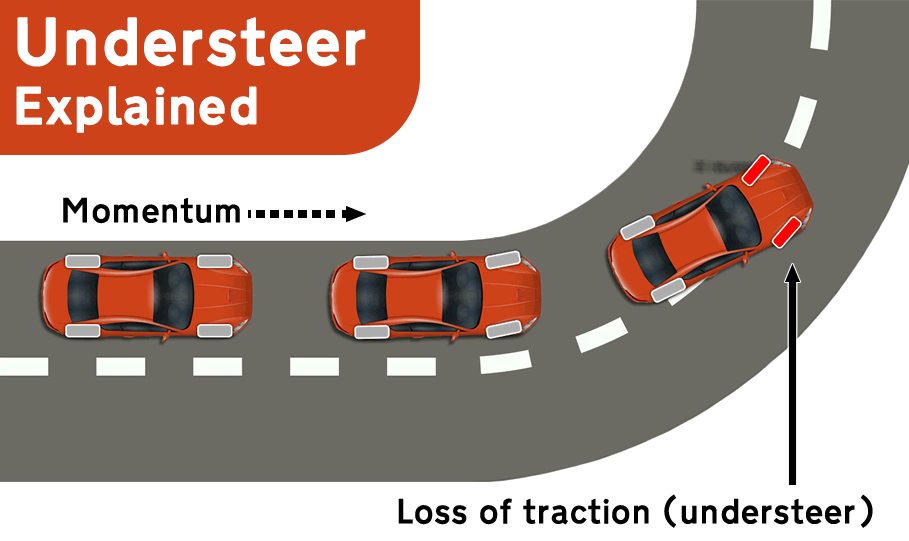What is Understeer in a Car Explained
In a car, understeer occurs when the front wheels lose grip during cornering. This means the vehicle will turn less than what the driver is intending, resulting in the car sliding to the outside of the corner.

What Causes Understeer?
The cause of understeer is usually due to excessive speed or hard braking while cornering. If the car’s wheels lock due to hard braking, it then becomes impossible to steer. The result from locked front wheels is that the car will slide across the road surface in an almost straight line.
Many cars now come equipped with ABS (Anti-lock Braking System) which prevents the wheels from locking. Though ABS doesn’t prevent understeer, it will allow the driver some steering control with the likely result being the car taking a much wider corner than the driver intended.
What’s Best, Understeer or Oversteer?
Understeer is generally considered safer than oversteer as it’s easier to correct. Understeer is most common in front-wheel-drive cars because the front wheels accelerate and turn at the same time. However, all-wheel-drive and rear-wheel-drive cars can also understeer.
How to Prevent Understeer
The only way to prevent understeer from occurring is to drive at an appropriate and safe speed for the road type and weather conditions.
The potential for understeer can also be reduced by keeping your car tyres inflated to the recommended pressures and by maintaining tyres with good tread depth (particularly important in wet conditions).
Most modern cars now come as standard with stability systems such as Electronic Stability Control (ESC). Car manufacturers have different names for this system such as Electronic Stability Program (ESP), Dynamic Stability Control (DSC) (along with a few other names). They all essentially do the same thing.
Always ensure you have your stability system switched on. These systems are specifically designed to keep understeer and oversteer under control and can be the difference between your car staying on the road and an accident.
How to Correct Understeer
If you do find yourself driving into a corner and your car is going in a straight line even though you’re turning the steering wheel, it’s understeering. To correct understeer you should:
- Reduce steering lock
- Ease off the throttle if you’re accelerating
- Ease off the brake if you’re braking
Reducing the Steering Lock
Most inexperienced drivers tend to attempt to fight understeer by increasing the steering lock – it seems the natural thing to do. However, the result of this actually increases slip angle (the angle in which the wheels are turned). The greater the slip angle, the less contact and usable material the wheels have with the road, which further reduces the traction of the tyres.
Ease off the Throttle if you’re Accelerating
Another mistake is to completely lift off the accelerator. By lifting off the throttle, vehicle weight distribution shifts to the front, meaning the rear becomes light. In this instance, the rear of the car can spin. This is called lift-off oversteer. If you are accelerating, ease off the throttle rather than completely.
Ease off the Brake if you’re Braking
If you’re braking when you car begins to understeer, hard braking may cause the wheels to lock and in that instance, you’ll have no steering control at all. You do want the vehicle to slow down, so continue braking, but reduce brake pedal pressure enough for the wheels to begin rotating again. By doing this, you may regain enough control over the steering to avoid an accident.
Rear-Wheel-Drive Cars
For rear-wheel-drive cars, the same techniques apply. There are certain techniques that skilled track drivers use. To negate understeer, the driver will often apply more throttle, causing the rear of the car to step out, reducing the amount of understeer. However, unless you have the skills to do this, it’s advised to follow the steps above.
What does a stability system look like in a Chevy Malibu to find out if it’s turned on. I bought a 2021 with no owners manual
Hi shelly.
The Electronic Stability Control (ESC) symbol looks like a car with tire skid marks under it. See Chevy Malibu dashboard warning lights. It’s on by default each time you start the car but it doesn’t tell you that it’s on. You only know if it’s off either by switching it off manually (generally you don’t want to do that) or if it has a fault. The warning light comes on (non-flashing) then. If the ESC is actively operating, the light flashes.